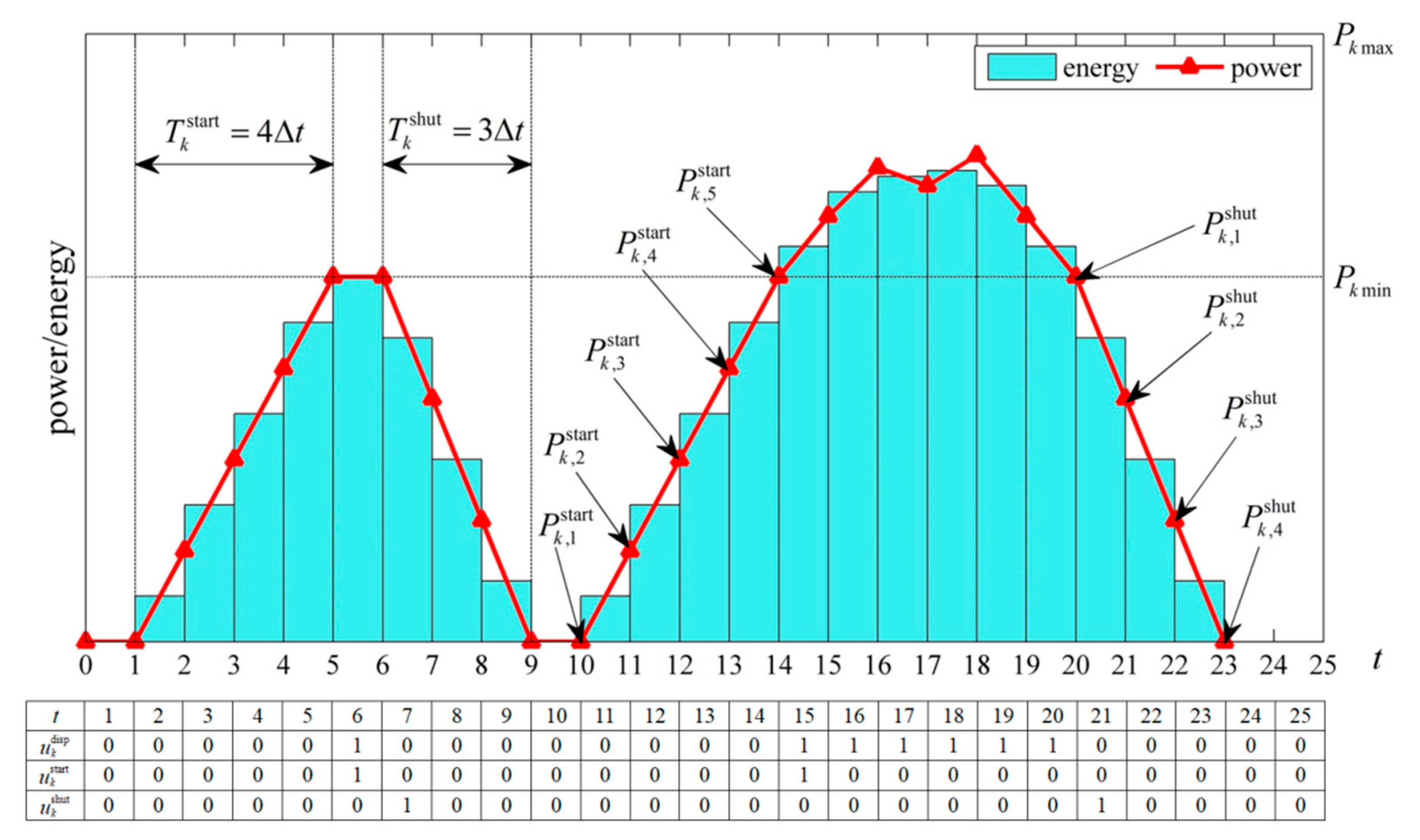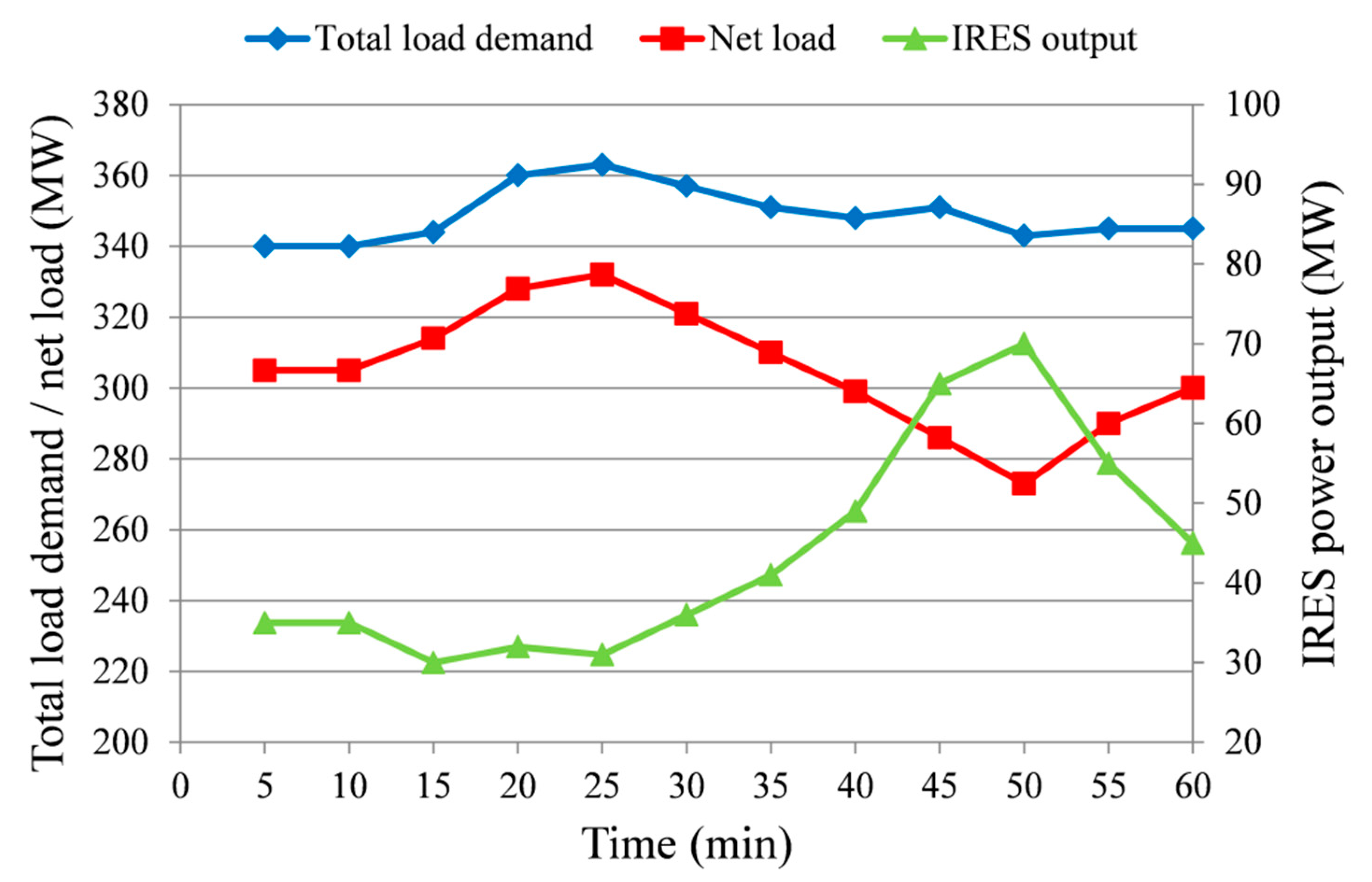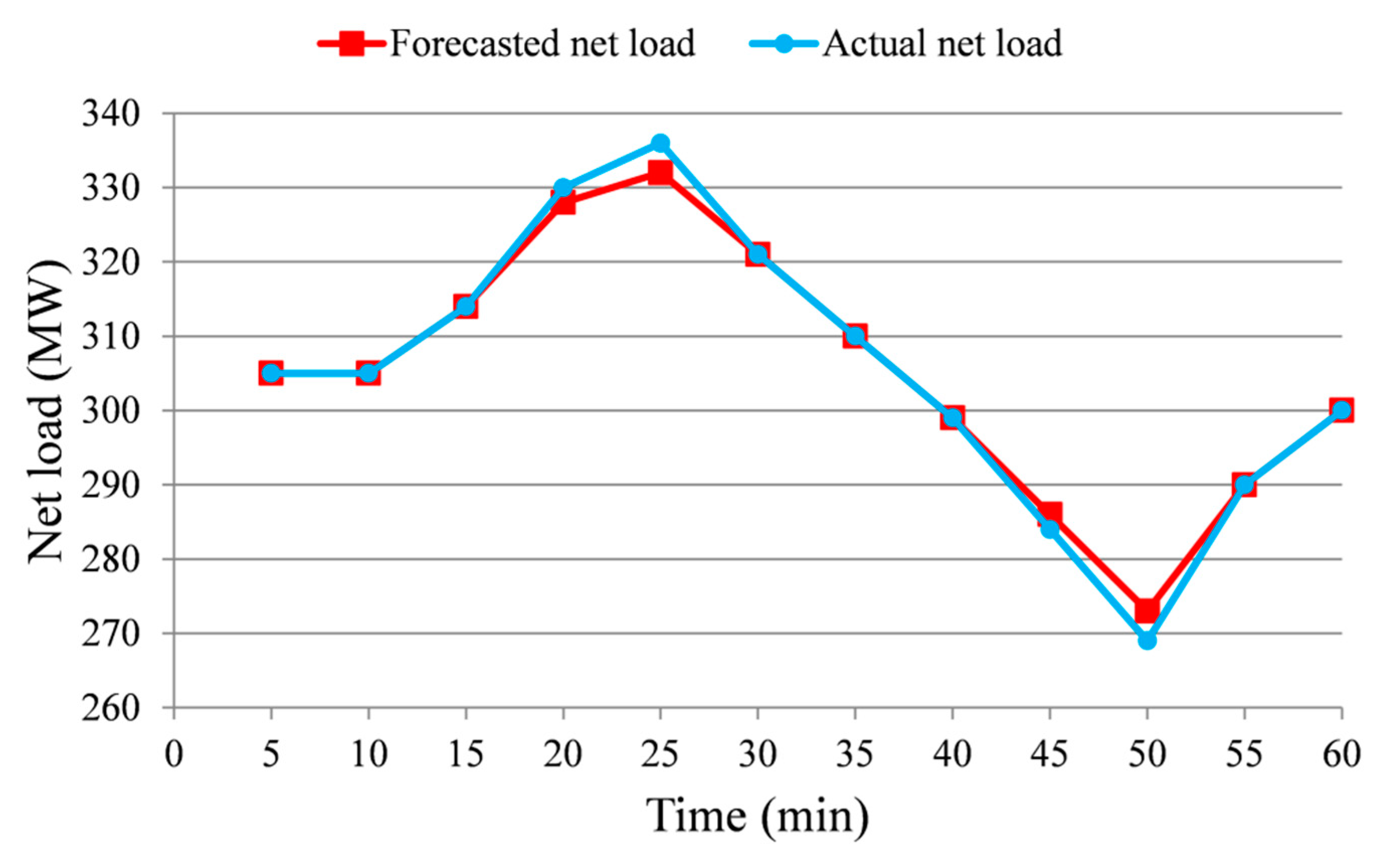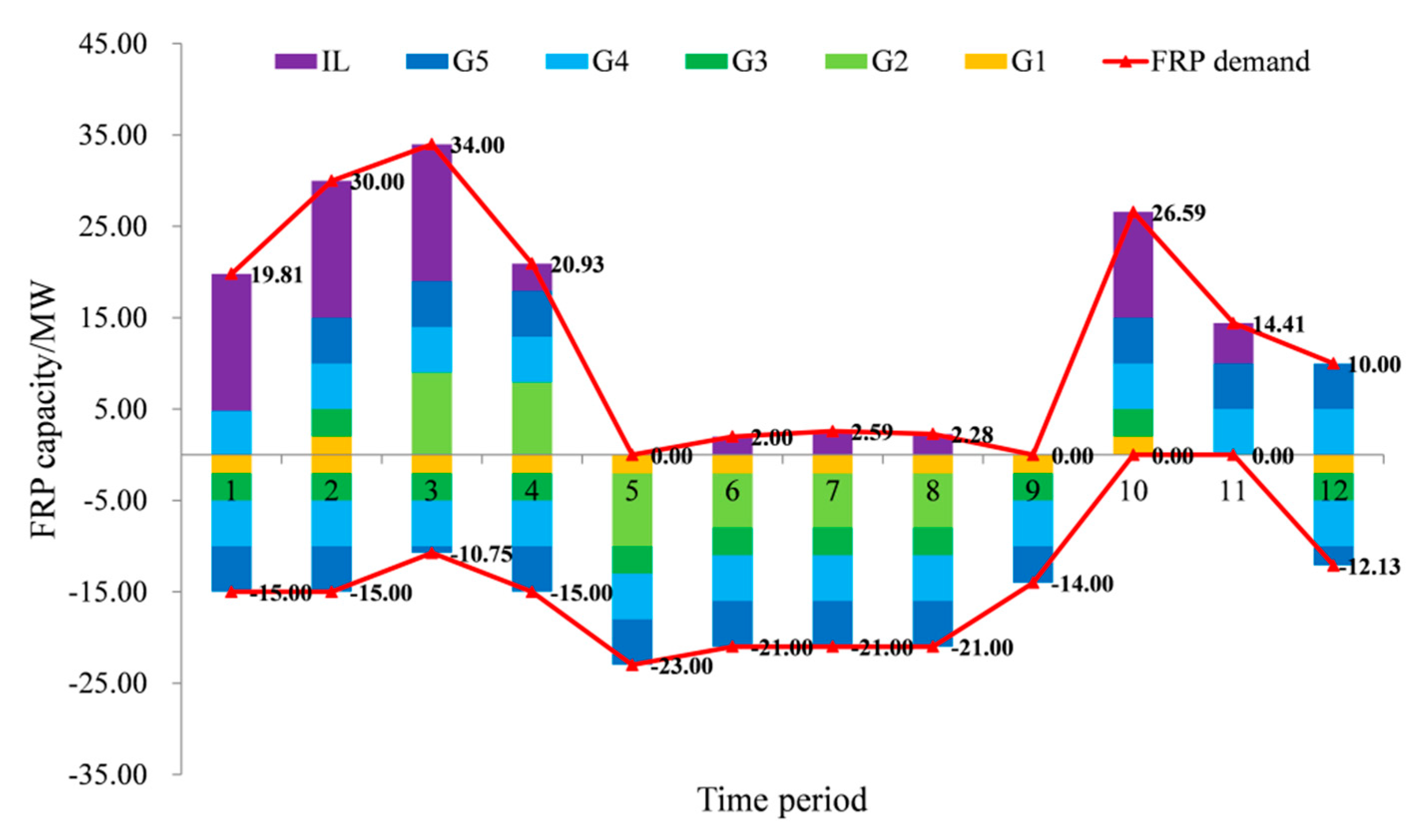Risk-Limiting Real-Time Economic Dispatch in a Power System with Flexibility Resources
Abstract
1. Introduction
- (a)
- A risk-limiting RTUC/RTED model with FRPs provided by conventional generating units and DR resources is formulated, in which the energy and ramping capabilities of conventional generating units during start-up or shut-down processes are also considered.
- (b)
- The CVaR is applied to describe the risk of the penalty for IRES curtailment and compensation for load shedding. The demand for ramping capability is then determined by reaching the compromise between economic performance and reliability.
- (c)
- A validation method that simulates the actual real-time operation is proposed. The proposed model is rolled forward against different realizations of uncertainties generated by Latin Hypercube Sampling method. The expected social surplus and realized operation cost can then be calculated. Different dispatch models will be compared.
- (d)
- The impact of FRPs on the operational flexibility of power systems and the impact of other factors on the system flexibility with FRPs are illustrated and analyzed.
2. Power System Flexibility
2.1. Definition of Flexibility and Acquisition of Flexibility Resources
2.2. Flexible Ramping Product
3. Problem Formulation
3.1. Upper Level
3.1.1. Objective Function
3.1.2. Supply and Demand of Power and Ramping Capability
3.1.3. Unit Commitment Logic
3.1.4. Power Output Constraints
3.1.5. Constraints of Ramping Capacity and Rate
3.1.6. Network Constraints
3.1.7. Bounds of Variables
3.2. Lower Level
3.2.1. Formulation of Conditional Value-at-Risk
3.2.2. Objective Function and Constraints
3.3. Solution Methology
3.4. Evaluation Approach
- (a)
- A baseline of the overall load demand and a baseline of the overall available power output from IRESs are given.
- (b)
- Samples for the overall load demand and the overall available power output from IRESs in each time period are generated by using the Latin Hypercube Sampling method according to their probability distributions.
- (c)
- Randomly scramble the order of sample points in each period, and then Nscen representative scenarios are selected based on the fast forward selection method. The probability ρs of each selected scenario is also obtained from the fast forward method.
- (d)
- The overall load demand and overall available power output from IRESs Ot are allocated to Dm,t, Qn,t and Oh,t at different buses, each following a predetermined proportion.
4. Case Studies and Numerical Results
4.1. The Role of FRPs in Enhancing the Operational Flexibility
4.2. Effects of the Confidence Level in CVaR on the Operational Flexibility
4.3. A Case Study on Guangdong Power Grid in China
5. Conclusions
Author Contributions
Funding
Conflicts of Interest
Nomenclatures
| Indexes | |
| h | Index for intermittent renewable energy generating units |
| i | Index for buses |
| j | Index for branches |
| k | Index for generating units |
| m | Index for user groups |
| n | Index for the interruptible load agents |
| s | Index for samples or scenarios |
| t | Index for dispatch time periods |
| z | Index reused in constraints |
| Parameters | |
| am | The proportion of the load demand of user group m in the load demand of all the user groups |
| bk,t | Bidding price of energy production of unit k at period t (in $/MWh) |
| dm,0 | Initial load demand of user group m at the t = 0 period (in MW) |
| gk,0 | Initial power output of generating unit k at the t = 0 period (in MW) |
| Ccom | Compensation price for load shedding (in $/MWh) |
| Fixed cost of generating unit k for a time period (in $) | |
| Shut-down cost of generating unit k (in $) | |
| Start-up cost of generating unit k (in $) | |
| Cpen | Penalty price for IRES curtailment (in $/MWh) |
| Dm,t | Maximum power demand of user group m at period t (in MW) |
| Actual (when t = 1) or forecasted (when t > 1) net load demand of the power system at period t, = − (in MW) | |
| Actual (when t = 1) or forecasted (when t > 1) total load demand of all users (including interruptible load participants) in the power system at period t, (in MW) | |
| / | Demanded upward/downward ramping capability for period t (in MW) |
| Fmax(Fjmax) | Rated flow limit matrix of branches with elements Fjmax (in MW) |
| H(Hji) | Power transfer distribution factor matrix of the system with elements Hji |
| M | A big number used in constraints, e.g., M = 999,999 |
| Na | Number of the interruptible load agents |
| Nb | Number of buses |
| Nbr | Number of branches |
| Ng | Number of generating units |
| Nres | Number of intermittent renewable energy generating units |
| Nscen | Number of generated scenarios |
| Nsam | Number of samples in the approximation of the CVaR integral |
| Nug | Numbers of user groups |
| Overall available power output from all intermittent renewable energy generating units in period t, (in MW) | |
| Oh,t | Available power output of intermittent renewable energy generating unit h in period t (in MW) |
| Pkmax/Pkmin | Maximum/minimum technical output of generating unit k (in MW) |
| / | Power output at the beginning of the zth period of the start-up/shutdown process (in MW) |
| Qn,t | Available capacity of interruptible load agent n in period t, normally determined in the day-ahead electricity market (in MW) |
| Rac | Acceptable extreme loss for ISO (in $) |
| / | Maximum ramping up/down rate of unit k during the dispatchable state (in MW/h) |
| T | Number of dispatch time periods |
| / | Minimum number of time periods required for start-up/shut-down of generating unit k |
| / | Maximum upward/downward changing rate of the interruptible load agent n (in MW/h) |
| Ut | An uncertainty factor considered in the calculation of demanded ramping capability at period t, whose value is related to the confidence level |
| β | Confidence level in the conditional value-at-risk |
| / | Bidding price of the upward/downward ramping products provided by generating unit k at period t (in $/MW) |
| Bidding price of the virtual power output provided by interruptible load agent n in period t (in $/MW) | |
| Bidding price of the upward ramping products provided by interruptible load agent n in period t (in $/MW) | |
| πm,t | Willingness-to-pay for electricity by user group m (in $/MWh) |
| ρs | Probability of scenario s |
| , | Variation in and a sample of Δ respectively (in MW) |
| Δt | Duration of a dispatch time period (in h) |
| Variables | |
| Energy production cost of generating unit k in period t (in $) | |
| dm,t | Load demand of user group m in period t (in MW) |
| ek,t | Energy scheduled for generating unit k in period t, excluding the energy production during the start-up or shut-down process (in MWh) |
| / | Demanded upward/downward ramping capability for period t (in MW) |
| gk,t | Total power output of generating unit k at the end of period t, including the power trajectories during the start-up or shut-down process (in MW) |
| lt,s | Auxiliary variable used in the lower level problem |
| oh,t | Dispatched power output of intermittent renewable energy generating unit h in period t (in MW) |
| pk,t | Power output over the minimum technical output of generating unit k at the end of period t (in MW) |
| () | Vector of nodal power injection with elements (in MW) |
| qn,t | Virtual generation output of the interruptible load agent n in period t (in MW) |
| Upward ramping products provided by the interruptible load agent n in period t (in MW) | |
| / | Upward/downward ramping products provided by generating unit k in period t (in MW) |
| Binary operating state variable of generating unit k in period t, with 1 standing for dispatchable (with power output exceeding the minimum level in the whole period) and 0 otherwise | |
| Shut-down variable, with 1 marking the beginning of the shut-down process of generating unit k in period t | |
| Start-up variable, with 1 marking the completion of the start-up process of generating unit k in period t | |
| αt | Value-at-risk at period t (in $) |
| , , κt,s, , , , , ε | Lagrange multipliers for constraints |
| Functions | |
| E(·) | Expectation of a random variable |
| Gk(ek,t) | Bidding function as well as the energy production cost of generating unit k in period t (in $) |
| P{·} | Probability of an event |
| V(·) | Variance of a random variable |
References
- Wu, C.Y.; Hug, G.; Kar, S. Risk-limiting economic dispatch for electricity markets with flexible ramping products. IEEE Trans. Power Syst. 2016, 31, 1990–2003. [Google Scholar] [CrossRef]
- Wu, H.Y.; Shahidehpour, M.; Alabdulwahab, A.; Abusorrah, A. Thermal generation flexibility with ramping costs and hourly demand response in stochastic security-constrained scheduling of variable energy sources. IEEE Trans. Power Syst. 2015, 30, 2955–2964. [Google Scholar] [CrossRef]
- Heydarian-Forushai, E.; Golshan, M.E.H.; Shafie-khah, M.; Sinao, P. Optimal operation of emerging flexible resources considering sub-hourly flexible ramping product. IEEE Trans. Sustain. Energy 2018, 9, 917–929. [Google Scholar]
- Lannoye, E.; Flynn, D.; O’Malley, M. Evaluation of power system flexibility. IEEE Trans. Power Syst. 2012, 27, 922–931. [Google Scholar] [CrossRef]
- Lannoye, E.; Flynn, D.; O’Malley, M. Transmission, variable generation, and power system flexibility. IEEE Trans. Power Syst. 2015, 30, 57–66. [Google Scholar] [CrossRef]
- Tanabe, R.; Amano, H.; Yokoyama, A. An analytical method for assessing flexible resource adequacy of power systems with a high share of renewables. In Proceedings of the IEEE Manchester PowerTech, Manchester, UK, 18–22 June 2017. [Google Scholar]
- Ulbig, A.; Andersson, G. Analyzing operational flexibility of electric power systems. Int. J. Electr. Power Energy Syst. 2015, 72, 155–164. [Google Scholar] [CrossRef]
- Ma, J.; Silva, V.; Belhomme, R.; Kirschen, D.S.; Ochoa, L.F. Evaluating and planning flexibility in sustainable power systems. IEEE Trans. Power Syst. 2013, 4, 200–209. [Google Scholar]
- Yang, J.W.; Zhang, N.; Kang, C.Q.; Xia, Q.; Miao, M.; Tian, X. Assessing the dispatch flexibility of coordinated solar and hydro generation. In Proceedings of the IEEE Power and Energy Society General Meeting, Boston, MA, USA, 17–21 July 2016. [Google Scholar]
- Dvorkin, Y.; Kirschen, D.S.; Ortega-Vazquez, M.A. Assessing flexibility requirements in power systems. IET Gener. Transm. Distrib. 2014, 8, 1820–1830. [Google Scholar] [CrossRef]
- Wang, Q.; Hodge, B. Enhancing power system operational flexibility with flexible ramping products: A review. IEEE Trans. Ind. Inform. 2017, 13, 1652–1664. [Google Scholar] [CrossRef]
- Marneris, I.G.; Biskas, P.N. Optimal scheduling of flexible ramping capacity in short-term electricity markets. In Proceedings of the Power Systems Computation Conference, Genoa, Italy, 20–24 June 2016. [Google Scholar]
- Wang, B.B.; Hobbs, B.F. A flexible ramping product: Can it help real-time dispatch markets approach the stochastic dispatch ideal? Electr. Power Syst. Res. 2014, 109, 128–140. [Google Scholar] [CrossRef]
- Wang, B.B.; Hobbs, B.F. Real-time markets for flexiramp: A stochastic unit commitment-based analysis. IEEE Trans. Power Syst. 2016, 31, 846–880. [Google Scholar] [CrossRef]
- Hu, J.H.; Wen, F.S.; Wang, K.; Huang, Y.C.; Salam, M.D.A. Simultaneous provision of flexible ramping product and demand relief by interruptible loads considering economic incentives. Energies 2017, 11, 46. [Google Scholar] [CrossRef]
- Hu, J.H.; Sarker, M.R.; Wang, J.H.; Wen, F.S.; Liu, W.J. Provision of flexible ramping product by battery energy storage in day-ahead energy and reserve markets. IET Gener. Transm. Distrib. 2018, 12, 2256–2264. [Google Scholar] [CrossRef]
- International Energy Agency. Harnessing Variable Renewables: A Guide to the Balancing Challenge; Organization for Economic Co-Operation and Development; International Energy Agency: Paris, France, 2011; p. 35. ISBN 9789264111394. [Google Scholar]
- North American Electric Reliability Corporation. Accommodating High Levels of Variable Generation; North American Electric Reliability Corporation: Atlanta, Georgia, 2009. [Google Scholar]
- Xu, L.; Tretheway, D. Flexible Ramping Products; California ISO: Folsom, CA, USA, 2012; Available online: http://www.caiso.com/Documents/DraftFinalProposal-FlexibleRampingProduct.pdf#search=Flexible%20ramping%20products (accessed on 1 May 2019).
- Navid, N.; Rosenwald, G. Ramp Capability Product Design for MISO Markets; Midcontinent ISO: Carmel, IN, USA, 2013; Available online: https://cdn.misoenergy.org/Ramp%20Product%20Conceptual%20Design%20Whitepaper271170.pdf (accessed on 1 May 2019).
- Chen, R.Z.; Wang, J.H.; Botterud, A.; Sun, H.B. Wind power providing flexible ramp product. IEEE Trans. Power Syst. 2017, 32, 2049–2061. [Google Scholar] [CrossRef]
- Alizadeh, M.I.; Moghaddam, M.P.; Amjady, N.; Siano, P.; Sheikh-El-Eslami, M.K. Flexibility in future power systems with high renewable penetration: A review. Renew. Sustain. Energy Rev. 2016, 57, 1186–1193. [Google Scholar] [CrossRef]
- Morales-Espana, G.; Baldick, R.; Garcia-Gonzalez, J.; Ramos, A. Power-capacity and ramp-capability reserves for wind integration in power-based UC. IEEE Trans. Sustain. Energy 2016, 7, 614–624. [Google Scholar] [CrossRef]
- PJM Interconnection. PJM Demand Response Strategy; PJM Interconnection: Valley Forge, PA, USA, 2017; Available online: http://www.pjm.com/-/media/library/reports-notices/demand-response/20170628-pjm-demand-response-strategy.ashx?la=en (accessed on 1 May 2019).
- Morales-Espana, G.; Ramos, A.; Garcia-Gonzalez, J. An MIP formulation for joint market-clearing of energy and reserves based on ramp scheduling. IEEE Trans. Power Syst. 2014, 29, 476–488. [Google Scholar] [CrossRef]
- Khodabakhsh, R.; Sirouspour, S. Optimal control of energy storage in a microgrid by minimizing conditional value-at-risk. IEEE Trans. Sustain. Energy 2016, 7, 1264–1273. [Google Scholar] [CrossRef]
- Rockafellar, R.T.; Uryasev, S. Optimization of conditional value-at-risk. J. Risk 2000, 2, 21–41. [Google Scholar] [CrossRef]
- Asensio, M.; Contreras, J. Stochastic unit commitment in isolated systems with renewable penetration under CVaR assessment. IEEE Trans. Smart Grid 2015, 7, 1356–1367. [Google Scholar] [CrossRef]
- Zhang, Y.M.; Han, X.S.; Xu, B.; Wang, M.Q.; Ye, P.F.; Pei, Y.N. Risk based admissibility analysis of wind power integration into power system with energy storage system. IEEE Access 2018, 6, 57400–57413. [Google Scholar] [CrossRef]
- Wang, J.H.; Shahidehpour, M.; Li, Z.Y. Security-constrained unit commitment with volatile wind power generation. IEEE Trans. Power Syst. 2008, 23, 1319–1327. [Google Scholar] [CrossRef]
- Growe-Kuska, N.; Heitsch, H.; Romisch, W. Scenario reduction and scenario tree construction for power management problems. In Proceedings of the IEEE Power Tech Conference, Bologna, Italy, 23–26 June 2003. [Google Scholar]
- Lofberg, J. YALMIP: A toolbox for modeling and optimization in Matlab. In Proceedings of the IEEE International Symposium on Computer Aided Control Systems Design, New Orleans, LA, USA, 2–4 September 2004. [Google Scholar]
- Liu, Y. Characteristics of wind power and impact on mid-and long-term development of Guangdong power system. Guangdong Electr. Power 2010, 23, 41–46. [Google Scholar]







| Unit k | Bus | Pmax (MW) | Pmin (MW) | g0 (MW) | Rup/Rdn (MW/5 min) | Tstart | Tshut | bt ($/MWh) | / ($/MW) | Cstart ($) | Cshut ($) | Cfixed ($) |
|---|---|---|---|---|---|---|---|---|---|---|---|---|
| G1 | 1 | 100 | 50 | 100 | 2 | - | - | 50 | 0.4167 | - | - | 0 |
| G2 | 2 | 60 | 18 | 0 | 8 | 3 | 2 | 100 | 0.8333 | 3000 | 250 | 0 |
| G3 | 3 | 100 | 40 | 100 | 3 | - | - | 60 | 0.5 | - | - | 0 |
| G4 | 6 | 80 | 30 | 80 | 5 | - | - | 80 | 0.6667 | - | - | 0 |
| G5 | 8 | 60 | 25 | 25 | 5 | - | - | 90 | 0.75 | - | - | 0 |
| IRES | 14 | 100 | 0 | 35 | - | - | - | 0 | - | - | - | 0 |
| User Group m | Bus | d0 (MW) | am (%) | Willingness-to-Pay ($/MWh) |
|---|---|---|---|---|
| 1 | 2 | 28.79 | 8.86 | 140 |
| 2 | 3 | 124.96 | 38.45 | 142 |
| 3 | 4 * | 58.51 | 13.39 | 144 |
| 4 | 5 | 10.08 | 3.10 | 146 |
| 5 | 6 | 14.86 | 4.57 | 148 |
| 6 | 9 | 39.13 | 12.04 | 150 |
| 7 | 10 | 11.94 | 3.67 | 152 |
| 8 | 11 | 4.64 | 1.43 | 154 |
| 9 | 12 | 8.09 | 2.49 | 156 |
| 10 | 13 | 19.23 | 5.92 | 158 |
| 11 | 14 | 19.77 | 6.08 | 160 |
| without FRP | Fixed FRP Demand (/ = 10) | Varied FRP Demand (50% Confidence Interval) | Risk-Limiting (β = 0.8, Rac = 1500) | Risk-Limiting (β = 0.9, Rac = 1500) | |
|---|---|---|---|---|---|
| Duration of G2 being dispatchable (Δt) | 0 | 0 | 3 | 0 | 2 |
| Energy provided by G2 (MWh) | 0 | 0 | 4.7531 | 0 | 3.3530 |
| Total operation cost ($) | 19,682.90 | 19,832.95 | 22,765.42 | 19,892.30 | 22,920.93 |
| Social surplus ($) | 29,164.69 | 29,014.00 | 26,101.67 | 28,986.53 | 25,957.90 |
| Probability of IRESs curtailment (counted in periods) | 0.0404 | 0.0351 | 0.0008 | 0.0197 | 0.0078 |
| Probability of IRESs curtailment (counted in scenarios) | 0.4280 | 0.3774 | 0.0097 | 0.2366 | 0.0938 |
| Quantity of curtailed IRES (MWh) | 0.1249 | 0.0999 | 0.0005 | 0.0487 | 0.0137 |
| Probability of load shedding (counted in periods) | 0.0959 | 0.0894 | 0.0279 | 0.0000 | 0.0000 |
| Probability of load shedding (counted in scenarios) | 0.9628 | 0.8842 | 0.2903 | 0.0000 | 0.0000 |
| Quantity of shed load (MWh) | 0.2232 | 0.2277 | 0.0839 | 0.0000 | 0.0000 |
| t | 1 | 2 | 3 | 4 | 5 | 6 | 7 | 8 | 9 | 10 | 11 | 12 |
|---|---|---|---|---|---|---|---|---|---|---|---|---|
| G1 (MW) | 100 | 100 | 100 | 100 | 100 | 100 | 100 | 100 | 100 | 98 | 100 | 100 |
| G2 (MW) | 0 | 0 | 0 | 0 | 0 | 0 | 0 | 0 | 0 | 0 | 0 | 0 |
| G3 (MW) | 100 | 100 | 100 | 100 | 100 | 100 | 100 | 100 | 97 | 94 | 97 | 100 |
| G4 (MW) | 75 | 70 | 75 | 80 | 79 | 74 | 69 | 64 | 59 | 54 | 53 | 58 |
| G5 (MW) | 25 | 25 | 28 | 33 | 38 | 33 | 30 | 27 | 25 | 25 | 25 | 27 |
| IL (MW) | 5 | 10 | 11 | 15 | 15 | 14 | 11 | 8 | 5 | 2 | 15 | 15 |
| t | 1 | 2 | 3 | 4 | 5 | 6 | 7 | 8 | 9 | 10 | 11 | 12 |
|---|---|---|---|---|---|---|---|---|---|---|---|---|
| G1 (MW) | 100.00 | 98.00 | 100.00 | 100.00 | 100.00 | 100.00 | 100.00 | 100.00 | 100.00 | 98.00 | 100.00 | 100.00 |
| G2 (MW) | 0.00 | 0.00 | 9.00 | 18.00 | 26.00 | 18.00 | 12.00 | 6.00 | 0.00 | 0.00 | 0.00 | 0.00 |
| G3 (MW) | 100.00 | 97.00 | 100.00 | 100.00 | 100.00 | 100.00 | 100.00 | 100.00 | 100.00 | 97.00 | 100.00 | 100.00 |
| G4 (MW) | 75.00 | 75.00 | 75.00 | 70.00 | 65.00 | 60.00 | 55.59 | 53.59 | 48.59 | 45.59 | 50.59 | 55.59 |
| G5 (MW) | 30.00 | 35.00 | 30.00 | 30.00 | 30.00 | 30.00 | 30.00 | 30.00 | 29.00 | 25.00 | 28.83 | 29.41 |
| IL (MW) | 0.00 | 0.00 | 0.00 | 12.00 | 15.00 | 13.00 | 12.41 | 9.41 | 6.41 | 3.41 | 10.59 | 15.00 |
| without FRP | Risk-Limiting (β = 0.9, Rac = 5000) | Risk-Limiting (β = 0.9, Rac = 104) | Risk-Limiting (β = 0.9, Rac = 5 × 104) | |
|---|---|---|---|---|
| Total operation cost ($) | 23.60 × 106 | 23.88 × 106 | 23.88 × 106 | 23.87 × 106 |
| Social surplus ($) | 48.20 × 106 | 47.82 × 106 | 47.82 × 106 | 47.92 × 106 |
| Probability of IRESs curtailment (counted in periods) | 0.0729 | 0.0417 | 0.0521 | 0.0521 |
| Quantity of curtailed IRES (MWh) | 194.51 | 125.30 | 139.02 | 161.60 |
| Probability of load shedding (counted in periods) | 0.0104 | 0 | 0 | 0 |
| Quantity of shed load (MWh) | 10.70 | 0 | 0 | 0 |
© 2019 by the authors. Licensee MDPI, Basel, Switzerland. This article is an open access article distributed under the terms and conditions of the Creative Commons Attribution (CC BY) license (http://creativecommons.org/licenses/by/4.0/).
Share and Cite
Lin, H.; Wang, C.; Wen, F.; Tseng, C.-L.; Hu, J.; Ma, L.; Fan, M. Risk-Limiting Real-Time Economic Dispatch in a Power System with Flexibility Resources. Energies 2019, 12, 3133. https://doi.org/10.3390/en12163133
Lin H, Wang C, Wen F, Tseng C-L, Hu J, Ma L, Fan M. Risk-Limiting Real-Time Economic Dispatch in a Power System with Flexibility Resources. Energies. 2019; 12(16):3133. https://doi.org/10.3390/en12163133
Chicago/Turabian StyleLin, Hongji, Chongyu Wang, Fushuan Wen, Chung-Li Tseng, Jiahua Hu, Li Ma, and Menghua Fan. 2019. "Risk-Limiting Real-Time Economic Dispatch in a Power System with Flexibility Resources" Energies 12, no. 16: 3133. https://doi.org/10.3390/en12163133
APA StyleLin, H., Wang, C., Wen, F., Tseng, C.-L., Hu, J., Ma, L., & Fan, M. (2019). Risk-Limiting Real-Time Economic Dispatch in a Power System with Flexibility Resources. Energies, 12(16), 3133. https://doi.org/10.3390/en12163133





